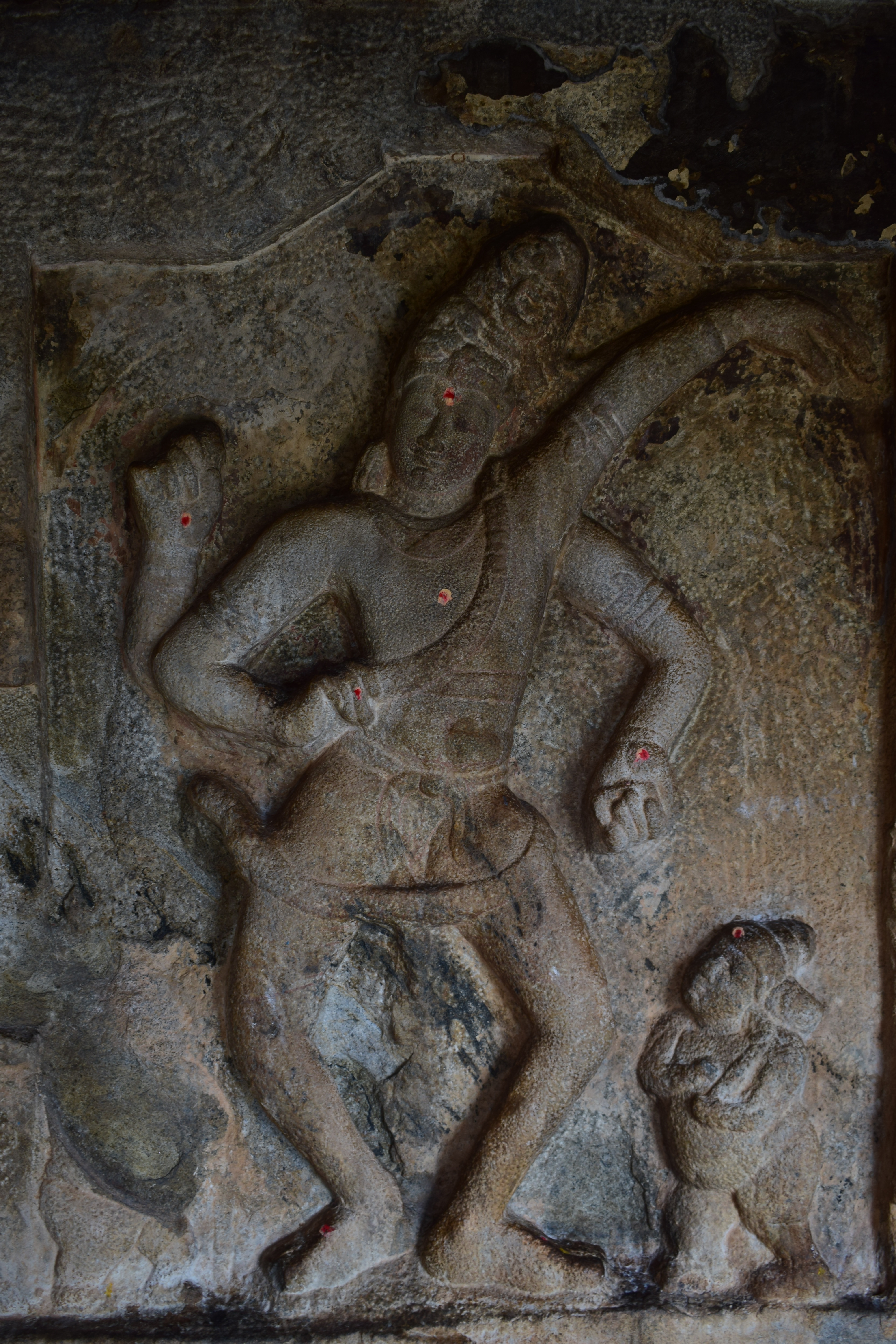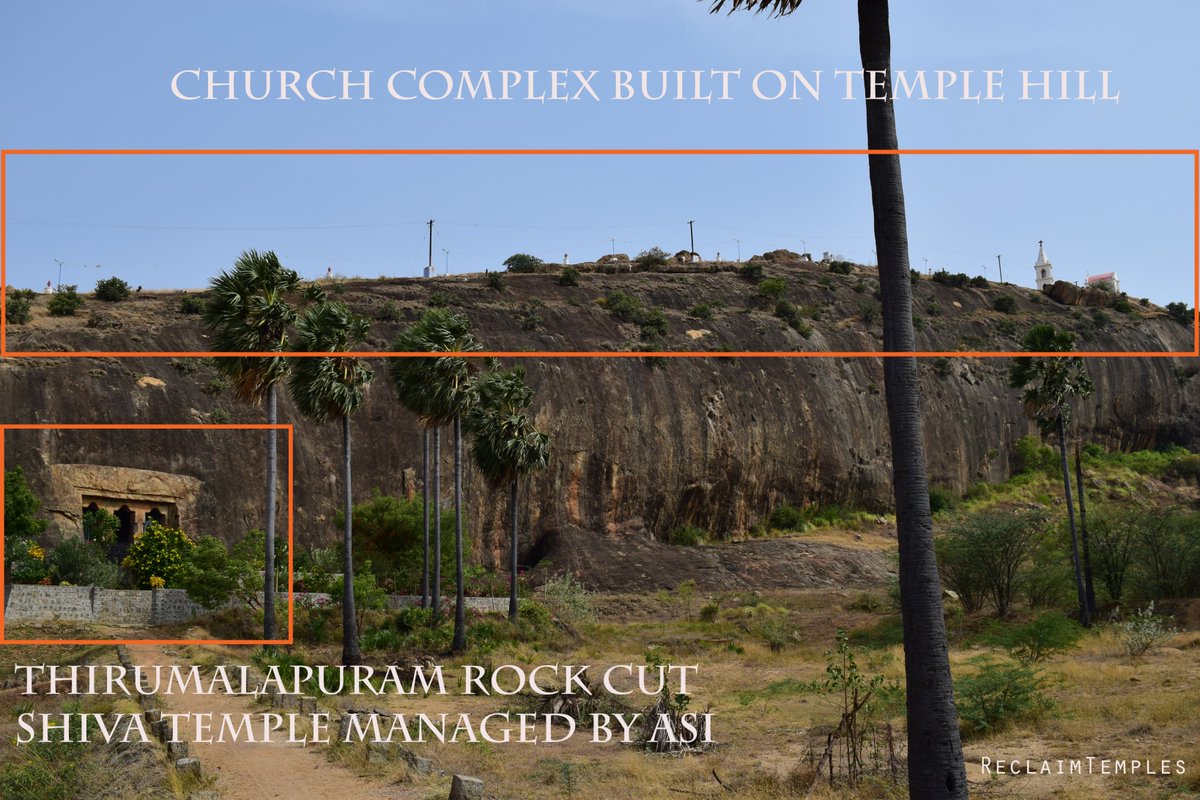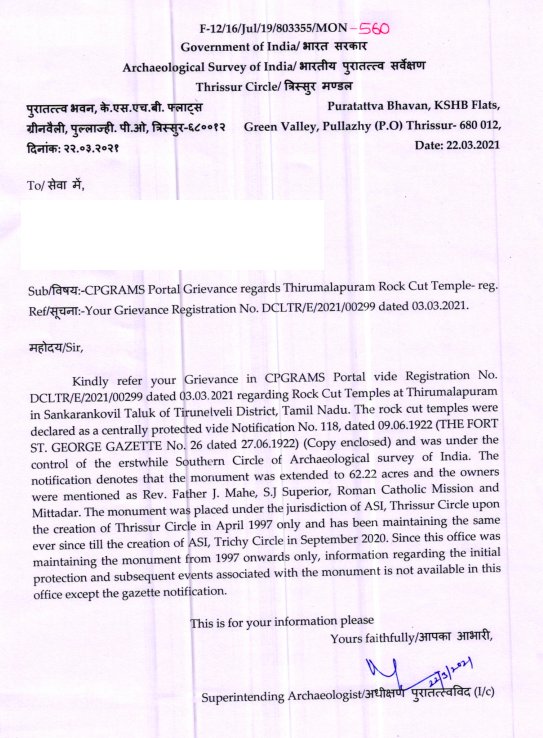![]()
Languishing Pandya Legacy
Thirumalapuram Rock Cut Temples—The Pasupathynatheswarar Temple, Tirunelveli District, Tamil Nadu.
Picture this: The rocky Varanasimalai hill (also known as Varanachimalai hill) in Thirumalapuram in Sankarankovil taluk of Thirunelveli district, Tamil Nadu. Step back into circa 750 CE, when the hill would have come alive with an army of craftsmen chiselling away into the rocky hill! Disregarding the blazing sun and the heat radiated by this rocky hill, they went on to carve out two temples from the solid rock face—the southern one is unfinished, while the north-facing one has been completed with finesse and is simply spectacular.
Today, twelve-plus centuries later, this temple—the Pasupathynatheswarar Temple—continues to be a sacred one for Lord Shiva’s devotees. There are special pujas here on every Pradosham Day (13th day of each lunar fortnight, a sacred day for Lord Shiva; praying on this day helps remove doshas or flaws in oneself) and on the annual Thiru Karthikai Day and the annual Maha Shivaratri Day.

The Pasupathynatheswarar Rock Cut Cave Temple is a marvel in stone and invokes an upsurge of emotions. An extensive temple chiselled out of a rocky mountain at a height of about 650 feet from ground level, this temple is reached by walking up a steep flight of steps that were carved out too. This ancient temple has a Façade flanked by pillars and pilaster, a Garbha Grha (Sanctum Sanctorum) dedicated to a Shivalingam, and a rectangular Mukha Mandappa (hall) with carved out niches housing exquisite, larger-than-life bas-relief sculptures of the Trinity of Hindu Gods—Brahma, Vishnu and Shiva—and Lord Ganapati.
A Nandi in the centre of the mandappa used to face the Shivalingam, like in any Shiva temple—used to, because the Nandi has been vandalized now and only its base remains, though supposedly, this temple is under the “protection” of the Archaeological Survey of India. Devotees continue to worship the remains of the Nandi even today.

Incredible Workmanship
As you walk through the façade into the temple, you step into the rectangular Mukha Mandappa (5.91m X 3.13m), which has three niches carved out on its southern wall. Imagine excavating so much of stone out of a rocky mountain without power tools! By the way, the floor of the Mukha Mandappa as well as the façade is levelled evenly. In fact, there the ancient Pandya architects have even fashioned a long groove across the entire length of the facade to drain away rain water! Such has been their attention to detail and care for this temple.
The pillars of the façade, with Brahma Kanta (cubical structures) at their top and bottom and an octagonal columns (Vishnu Kanta) between them, is adorned with lotus medallions. There are Taranga potikas or fluted corbels above them.
Priceless Bas-Relief Sculptures
The bas-reliefs of this temple are among the finest examples of Early Pandya Art and mesmerize us by their sublime aesthetics, besides evoking awe at the kind of devotion that the king of the day and the craftsmen must have had, to have attempted and accomplished this marvelous stone temple.
Lord Nataraja in chatura tandavam
The beauty of Lord Nataraja here, with his left foot slightly raised and the right foot on the floor is to be seen to be understood. The first niche (1.86m X 1.41m) of the Mukha Mandappa features a beautiful, four-armed, dancing Lord Shiva (Nataraja) in the ‘chatura tandavam’ dancing pose (the 107th dance posture among the 108 dance postures of Shiva). Bhootha Ganas stand on either side of him; the Gana on his right has been destroyed and only his legs remain, while the Gana on his left is seen playing the sirattai kinnari (a traditional Tamil musical instrument) with his right hand.
Lord Nataraja—with a cresent moon to the left of his jatamukuta (crown of braids)and the braided locks flowing down his shoulders—is seen holding a flower in his rear right hand, while he holds the yajnopavita (sacred thread) withhis front right hand, a palm leaf manuscript in his rear left hand, and has his front left hand stretched out above his shoulder. With a serpent coiled around his waist and thighs, an elaborate girdle with a floral clasp tying the short garment that he wears around his waist, adorned by serpentine spiral armlets and anklets, a palm leaf coil on his right ear lobe, a forearm band, a yajnopavita and udara bandha—Lord Shiva here is a sight of incredible beauty and mesmerising power.

The middle niche (1.90m X 1.40m) has a beautiful bas-relief of four-armed Lord Vishnu in standing posture. He is seen holding a sankha (conch) in his rear right hand, chakra (discus) in his rear left hand; his front left hand is on his waist and his front right hand is in Anjali Mudra. Lord Vishnu has been depicted wearing makara kundala on his ear lobes, a krita makutam with wheel, udhara bandha and yajnopavita, and adorned with sarapali, armlets and a forearm band, and attired in his pitambara garment in panchakacha style. There is a bhootha gana on either side of Lord Vishnu, their faces expressing entranced devotion.

Next to this is the niche (1.68m X 1.34m) with the bas-relief of a seated Lord Ganesha. Lord Ganesha here is an Idampuri Pillaiyar in Maharajaleelasanam. He is seen holding the pasa with his rear right hand and the tusk with his rear left hand. His front left hand is seen resting on his belly, while his front right hand holds a modhakam. Lord Ganesha is adorned with karantamakutam, armlets, fore-arm band, udhara bandha, and yajnopavita.

A Rare Sight
This is also one of the rare temples with Lord Brahma. On the eastern wall of the mukha mandappa of this temple is a niche with the relief sculpture of Brahma in standing posture with three visible heads and four arms. His right front arm rests on his hip, while his left front arm holds a dried bottle gourd. He holds a flower with his right rear arm and a palm leaf manuscript in his left rear arm. Lord Brahma is seen wearing a dhoti in panchakacha style. He is adorned with a jatamakuta, yagyopavitam (the sacred thread), sarapuli, udharabandha, keyura, and thick bangles.

Shivalingam That Has Seen Centuries of Abhishekam
The garbha grha (sanctum sanctorum) of the temple lies on the western side of the carved out Mandappa, and is flanked by Dwarapalakas (gate keepers) at its entrance. At the centre of the sanctum sanctorum is a monolithic Shiva Lingam with squarish Avudaiyar (base). In the centre of the hall and facing the Shiva Lingam is the remains of a monolithic Nandi. One can see from the lingam that regular abhishekam was once performed for the Shiva Lingam. Jagathi, vritta kumudham and prathivari elements are present in the plinth (prathivari bandha adhitanam) of the sanctum sanctorum.
Inscriptions Demonstrating Local Patronage of the Temple
Traces of early Pandya murals and a couple of later-day inscriptions adorn the temple. Of the two inscriptions, one is a 11th century inscription while the other is a 12th century inscription (under one of the pillars) that mentions that a prince named Chakravartin Srivallabhadeva had gifted fertile land with trees, wells and tanks to the temple, demonstrating that widespread worship of these Hindu deities was prevalent in Tamil Nadu even then.
History of the Temple
The architecture style of this temple has been classified as the ‘Early Pandya Style’. Visualize the effort and the devotion that has gone in to carve out such poetry in stone from this unyielding rock of a mountain! The Thirumalapuram Rock Cut Cave Temples is a site of invaluable religious, historic and artistic value throwing light on the deep-seated Hindu ethos of Tamil Nadu.
On paper, the temple is supposed to be a ‘Centrally Protected Monument of National Importance” and preserved and maintained by the Archaeological Survey of India, Thrissur Circle. The bitter reality is that the Nandi has been vandalised and not much has been done to protect or highlight the importance of the temple.
This historic temple was carved out at a time when Pandya kings ruled this region. Temple art and culture flourished under their devout patronage and this was supported by the prosperity brought in by pearl trade across oceans by the Pandyas, such that the Pandya empire came to be tagged as ‘the richest kingdom in existence’ by venetian traveller and writer Marco Polo, who explored the Pandya Empire in the 13th century, after arriving at its port Kayal. Historical records state that King Maravarman Rajasimha I ruled between 730–65 CE, followed by the rule of Nedunjadaiyan/Varagunavarman from 765–815 CE.
A Tale of Woe: Regular Worship Prohibited; Lord Shiva Awaits His Due
History narrates that the Pasupathynatheswarar Temple was all along a functioning temple thronged by devotees from far and near, until in 1922 when these ancient cave temples were brought under the “protection” of Archaeological Survey of India. From a time of daily worship at the temple, it has come to pass that devotees have had to go to court to get the rights to celebrate the annual overnight Maha Shivaratri at the temple, with the ASI once restricting the customary overnight Maha Shivaratri celebrations here from sunrise to sunset (https://indiankanoon.org/doc/249161/).
A pertinent point that is recorded in this writ appeal is that “originally regular poojas were being offered by the devotees at this temple; the regular worship was interrupted only after the Thirumalpuram rock cut temples were declared to be an ancient monument in the year 1922 under the Ancient Monuments Preservation Act, 1904 and came under the ASI.”
Can the ASI interfere and put a spoke in the religious affairs of a community?
Priceless Pandya Legacy Lies in Languish
Today, as you walk up the path leading to this centuries-old temple, you will find an entire church complex staring down at you from atop this very mountain, with crosses and Church buildings all over the place.

A “Sendamaram Tirumalaimatha Church” now stands on top of Thirumalapuram Cave Temples that is under the “protection” of the ASI. Notice the name “Thirumalainatha” meaning “lord of Thirumalai” and closely patterned on the lines of Pasupathynatheshwarar! How could such blatant appropriation be allowed? This church is under the Diocese of Palayamkottai and their website openly states that the Church was built after destroying an ancient temple and using its materials: “First Sendamaram had only a small thatched church as its possession…. and he built up a chapel with the stones of a dilapidated Hindu Temple.” (http://www.palayamkottaidiocese.org/diocese/shrines/8) .
As it to add insult to injury, the Church complex built on the encroached temple hill has put up facilities and shelter spaces for Christian pilgrims and priests, while the Pasupathynatheshwarar Temple that has been in existence for centuries has no facilities for Hindu devotees.

A Case of Bizarre Ownership
To a complaint, the ASI has replied that the ownership of 62.22 acres of land including the Thirumalapuram rock cut Shiva temple belongs to Rev Father J Mahe, SJ Superior of Roman Catholic Mission (https://twitter.com/reclaimtemples/status/1374014951040282628?lang=en). This is a slap on the face to the devotees of Pasupathynatheswarar and the Pandya kings who have built this marvel in stone.

How is even possible for a later-day church to lay claim on a hill that has been the site of a temple for twelve-plus centuries? How could this historic temple site be under Christian occupation? Is it even legal?
Footnote: The Thirumalapuram rock cut temples lie about a kilometer away from the Thirumalapuram Bus Stop on the Senthamaram-Kallidaikurichi road, about 5km from Kallidaikurichi. Neolithic tools and other archaeological finds unearthed in this region point out that Thirumalapuram was the site of civilization even 10,000 years ago.
This research article is part of our efforts to locate and document ancient Hindu temples that is under encroachment and ruins. Efforts are then made towards their revival and restart of worship. You can support via https://reclaimtemples.com/donations/documenting-destroyed-ancient-temples/ . This will strengthen the efforts and enable us make interventions on ground.
#ReclaimTemples

